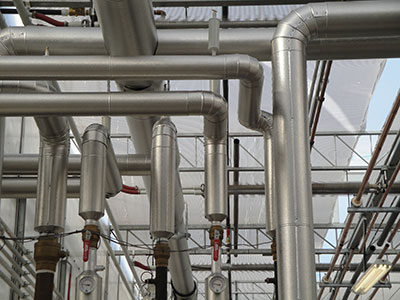
As a greenhouse grower or manager, it’s easy to get caught up in the
day-to-day activities and allow the little items to get missed.
As a greenhouse grower or manager, it’s easy to get caught up in the day-to-day activities and allow the little items to get missed.
 |
|
| Don’t overlook insulating pipes where heat is not needed. PH0TOS COURTESY GGS Advertisement
|
When it comes to energy issues, these little items can really add up! Energy conservation has been a popular topic of conversation, but there are many aspects that are often overlooked by today’s growers.
Energy curtains have been noted as a quick payback in the energy savings market. Most growers make sure that they are taking full advantage of their impact by tweaking their climate control system from season to season and keeping it in good operational order.
But how many growers measure the effectiveness of the curtain itself as it ages?
Manufacturers suggest that the maximum lifetime of an energy curtain is eight to 10 years, and UV degradation can occur after as little as five years. It is common to retain curtains far past this limit as long as they are not showing major signs of damage such as shredding or ripping.
Is this the best way to cut costs or would it be wiser to replace that energy curtain according to the manufacturer’s suggestions? It is best to keep records of the date of installation of all energy curtains with a date of replacement predetermined. If energy curtains are allowed to remain in place after their efficiency is compromised, energy will be wasted.
ANY ENERGY BEING WASTED?
■ At home we are often reminded of energy wasted when lights or appliances are kept running unnecessarily. Why can this not be a concern at the greenhouse?
How many times are offices or computer rooms left empty with lights on, air conditioning running, etc.? A grower can be preoccupied in the greenhouse for hours before visiting his office.
It is often overlooked that energy is wasted when electrically powered items are on unnecessarily. A 5,000 BTU window unit air conditioner, for example, can cost upwards of $50 per month in electricity; if there are multiple offices with such cooling units, this can become quite an expense. Be aware of electrical costs and conserve accordingly.
Another problem often overlooked is the heat loss that occurs when doors are left open unnecessarily.
How often does someone pass through a man-door and leave it open for an extended period? Whether it’s in the greenhouse or the warehouse, cold air will infiltrate that area and extra energy is needed to warm it again.
Prevention for this common occurrence is to install door-closing springs on every man-door to avoid them being left open. Take this a step further and make sure that latches catch properly so that the wind cannot fling a door open and the door is properly weatherstripped to eliminate drafts.
CHECK OVERHEAD DOORS
■ Overhead doors can also be a source of wasted energy. If the weatherstripping is worn or they do not close tightly, there will be cold air penetrating, especially on the windy winter days. Take the time to check each overhead door for issues before the cold weather sets in.
A good measure is to educate the staff on how important it is during the winter season to open overhead doors only as long as necessary, have a procedure and post it beside the door as a reminder. It’s unfortunate, but entranceways into the greenhouse are a common cause of energy waste. Scheduling a maintenance person to check each door in the facility for inadequacies annually before the cold weather arrives will conserve a surprising amount of energy.
TOO HOT IN THE BOILER ROOM?
■ Boiler rooms are often described as the “hottest areas of the greenhouse.” This does not have to be the case. In fact, if this is the situation, then there might be an insulation issue.
Concerns are often centred on the efficiency of boilers and recovering wasted heat through a flu-gas condenser. The colossal heat loss from pipes that are not insulated is not recognized.
A greenhouse does not need a “hot” boiler room; the heat is required in the greenhouse. If the boiler room is unusually warm, have a look around. Are there bare pipes radiating in that area?
Often heat system installations get to a point where everything is working as designed but the finishing touches are left incomplete.
Insulating pipes where heat is not needed is usually last on the list and often overlooked. Do your own heating system audit and determine if you need to insulate. The capital cost will be outweighed by the energy savings!
ENERGY EFFICIENT LIGHTING PROGRAMS
■ High intensity lights are often necessary in the greenhouse environment and are indeed a burden with their energy requirement, but how much time is spent analyzing how to use them efficiently?
 |
|
| Duane Van Alstine
|
Whether the lights are used for creating long-day conditions or as a supplement to solar conditions, there is a risk of energy wastage.
Whatever type of lighting used in the greenhouse (fluorescent, HID or LED), there are decisions that are made that can greatly influence energy conservation.
With supplemental lighting, the crop will determine at what external light levels the lights need to be turned on, but the time frame that passes at the low light level before this occurs is in the hands of the grower.
HID lights, for example, take a large amount of energy to get to full intensity; you do not want to be cycling on and off unnecessarily throughout the day by having the lights react too quickly.
The grower needs to look at a reasonable time span of low light before initiating the supplemental lighting. In the case of additional light for extending the daylength of a plant, a grower can look at numerous factors. What time of the evening is electricity the cheapest, and what time does the crop need the additional light?
Decrease this supplementary light source as the days get longer. Generally this is looked at seasonally and the daylengths are not considered until it is officially long-day conditions (around March 17).
Greenhouse lighting is a big contributor to the total energy bill. Take the extra time to investigate the small details and it will save dollars.
The points mentioned here are but a few of the areas where energy savings are a concern. Today’s grower is always conscious of efficiency, especially when dealing with energy, as it is the second greatest expense of a greenhouse operation. The next time you look at your energy curtain, boiler room, office, entranceways or HID lights, view them with a more critical energy-conscious eye!
Duane Van Alstine is the general manager of Niagrow Systems Ltd., which specializes in greenhouse heating solutions. More information can be found at www.niagrow.com .
Print this page